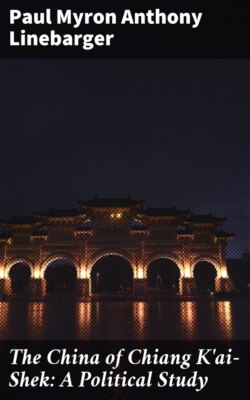Читать книгу The China of Chiang K'ai-Shek: A Political Study - Paul Myron Anthony Linebarger - Страница 7
На сайте Литреса книга снята с продажи.
The Hankow Period
ОглавлениеTable of Contents
The greatest part of the year XXVII (1938) was spent in continuation of slow retreat and heavy frontal resistance. Until October communications with the outside world were wide open through the railroad to Canton. Heavy supplies could arrive by the shipload. Hundreds of Japanese air attacks on the railroad disrupted schedules but never led to serious suspension of service. Leftist influence became overwhelming in Hankow. That city had been the capital of the ill-fated Wu-han Kuomintang-Communist government, which fell with the secession of Chiang to Nanking eleven years before; its connotations still lingered. Even conservative Kuomintang leaders, who had gone to lengths of appeasement at which Neville Chamberlain would have blanched, tried to talk like Negrin or Alvarez del Vayo.
In January 1938, two organizations were formed which, along with the Communist zone in the Northwest, were to be among the most active agencies of guerrilla leadership. The first of these was the New Fourth Army (Hsin-ssŭ-chün), which emerged in the area just south of the Japanese forces at the Yangtze mouth. It was composed of peasant and student militia, of regular army fragments, and of some Kuomintang volunteers, under the leadership of Communist remnants which had hidden away, banditti-fashion, when the Red Army trekked Northwest. Its emergence was recognized by legal order of the National Military Affairs Commission.[10] The other organization was the Provisional Executive Committee of the Shansi-Chahar-Hopei Border Region (Chin-ch'a-chi Pien-ch'ü Lin-shih Hsing-chêng Wei-yüan-hui), established by a conference at Fup'ing, January 8–15, and authorized by central government mandate. This agency also sprang from Leftist organizations—in this case, a bold, determined, student-peasant guerrilla army—which had first developed despite government opposition. It was designed to provide an emergency guerrilla government for those portions of the three provinces which were under occupation by the Japanese. Unoccupied portions of the provinces retained their existing administrations.
In the next month, February 1938, there was established an agency of supreme importance, the Supreme National Defense Council.[11] This replaced the Central Political Council,[12] which had exercised routine functions of the Party's sovereign control over the government; like its predecessor, the Supreme National Defense Council tended to act as the supreme governmental organ, although it was technically a Party organ. The Council provided and provides a unified civilian-military control for the duration of the war; but the Kuomintang shares its power with other groups only in the consultative organs of state, not in the executive.
March 1938 followed with another political step forward—the Emergency Session of the Kuomintang Party Congress. The Party Congress had the functions of a special constituent assembly in part, and in part those of a restricted parliament; in this session two further actions were taken. The first was the adoption of the momentous Program of National Resistance and Reconstruction (K'ang-chan Chien-kuo Kang-ling),[13] which provides a plan for the war and commits the Kuomintang and the National Government to a policy of victory, of industrialization, and of economic reform as a means to war.
The second step taken by this important Congress was the provision for a People's Political Council (Kuo-min Ts'an-chêng Hui, also translatable as People's Advisory Political Council). This was the first breach in the Kuomintang monopoly of government since the establishment of the Party dictatorship.[14] The government, through the constitutional fiction of appointing members as representative individuals, provided a rough, approximate, but fair representation of the active political forces in China.
While the Emergency Session of the Party Congress took these steps for further national defense, the Japanese were collecting a coterie of ex-politicians, friends of Japan, and old men to serve as the Reformed Government of the Republic of China at Nanking. They disregarded the anomaly of having two "Chinese" national governments—the Provisional Government in Peiping being undisturbed by these measures—and continued to seek the division of China, even on the level of the pro-Japanese States. The Reformed Government was established on March 27, 1938.
The autumn of 1938 brought another phase of discouragement. Relying on the prestige of British power and the nearness of Hong Kong, the Chinese were not watchful in the Canton area. The Japanese landed almost unopposed. Chinese negligence, corruption, and a little treachery worked in their favor. The landing forces performed almost superhuman feats of endurance in forced marches overland; on several occasions Japanese advance troops ran so far ahead of schedule that Japanese warplanes, thinking them disguised Chinese, strafed them![15] Canton fell without a major battle. Hankow, the great radical capital, scene of the 1926–27 Leftist upsurge and of the anti-Fascist enthusiasm of 1938, was entered by the Imperial Japanese army, and the entire Wu-han area was lost to China.
Not only was the Hankow period ended. By breaking the last rail connection of the Chinese government and the outside world, and by driving the Chinese leadership into the remote interior, Japan shut off the ready play of international influence on domestic Chinese politics. Foreign visitors became more rare. The government, moving to the mountain fastnesses of Szechuan, found a home on the great Gibraltar-like promontory of Chungking city, tiered along cliffs above the Yangtze and Kialing rivers. The last withdrawal was a final test of strength. Hankow, six hundred miles up-river, was commercially, architecturally, and politically a coastal city. It was still an outpost of world imperialism and of modern technology. With the next remove the Chinese government found itself beyond tangible Western influence; for the first time since 1860 the capital was out of the military reach of Western powers, and in a city which had only slight traces of Western influence.
